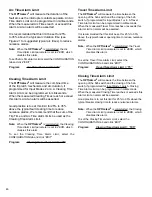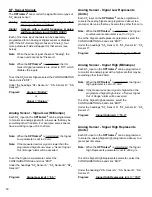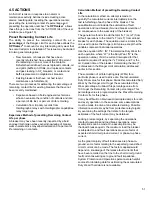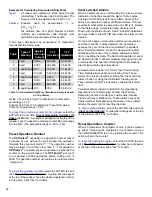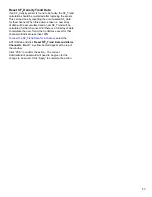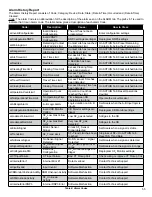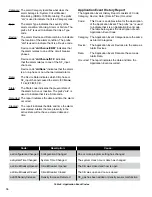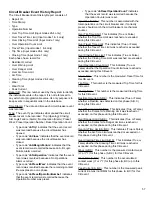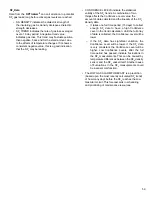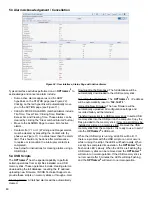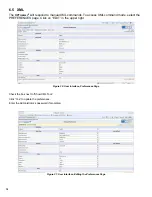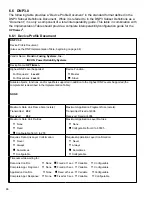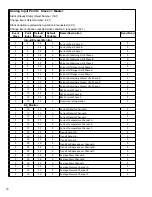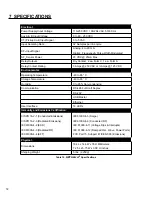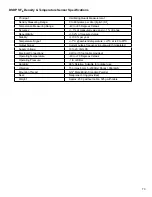
58
SF
6
Logged History Report
The SF
6
Logged History Report consists of: Record
ID; Time Stamp; Density (A,B,C); Pressure (A,B,C);
Temperature (A,B,C).
Record ID: This is a number used by the system to identify
the individual records in the report. It is not referenced to
any external or programmable value. Its only purpose is to
keep records in sequential order in the database.
Time Stamp: The date and time each SF
6
record was
logged.
Density (A,B,C): The measured density (Grams / Liter) for
this input channel (A,B,C) at the time the density record
was logged.
Pressure (A,B,C): The calculated pressure (in the chosen
units) for this input channel (A,B,C) at the time the gas
record was logged.
Temperature (A,B,C): The measured temperature (in the
chosen units) for this input channel (A,B,C) at the time the
density record was logged.
SF
6
Daily Summary Report
Date Stamp: The date each SF
6
Summary record was
logged.
Average Density (A,B,C): Average density (Grams/Liter)
for the past 24 hours.
Average Pressure (A,B,C): Average pressure (in the
chosen units) for the past 24 hours.
Average Temperature: Average temperature (in the chosen
units) for the past 24 hours.
Density Trend (A,B,C): The calculated SF
6
Density Trend
(Grams / Liter / day) for this input channel (A,B,C) at the
time the gas record was logged.
Pressure Trend (A,B,C): The calculated SF6 Pressure
Trend (in the chosen units) for this input channel (A,B,C) at
the time the gas record was logged.
Trend Conf (A,B,C): The calculated SF
6
Trend Confidence
Level (%), for both density and pressure, for this input
channel (A,B,C) at the time the gas record was logged.
Average Mass: Average mass (in the chosen units) for the
past 24 hours.
Mass Change: The calculated change in mass (in the
chosen units) over the past 24 hours, a negative number
represents mass lost, a positive number represents mass
gained
Accumulated Mass Loss: A running total of mass loss (in
the chosen units), from the beginning of the Date Range
to the date of that record in the report, a negative number
represents mass lost. Accumulated Mass Loss is not
affected by gas filling events.
Data Interpreting
Circuit Breaker Data:
Data from the
OPTI
mizer
2
reveals absolute setpoint limit
violation and trends in degradation:
• The phase segregated
I
2
x T
or
I x T
per trip event
values allow analysis of the duty wear impressed
on the breaker for that particular operation. Fault
type can often be determined by examining which
phase(s) has a higher value than the other phases.
• The phase segregated
I
2
x T
or
I x T
accumulated
per phase allows analysis to determine which
pole(s) are nearing their life limits. Other uses for
this value involve correlation to grid (baffle) wear, oil
contamination, and gas contamination.
• The TRAVEL TIME (Opening Mechanism Time)
allows trending of the mechanical speed of the
breaker. Rapid departures from normal values
suggest a mechanical compromise requiring urgent
attention. Small departures over a long time period
may indicate a minor maintenance item, such as
lubrication.
• The TRIP TIME (Breaker Trip Mechanism Time)
allows trending of the mechanical speed of the
tripping mechanism. Rapid departures from normal
values suggest a mechanical compromise requiring
urgent attention. Small departures over a long time
period may indicate a minor maintenance item, such
as lubrication. Although no “Trip Coil Signature”
data is recorded, the TRIP TIME measurement can
indicate general condition and effectiveness of the
tripping mechanism.
• The ARC TIME (Arc Duration) allows trending of the
dielectric capabilities of the breaker. By examining
the ratio of TRAVEL TIME to ARC TIME, it can be
determined if the ARC TIME is growing in duration
while the TRAVEL TIME remains constant. If this is
observed, a compromise in the dielectric quality of
the breaker is suggested. Rapid departures from
normal values suggest a dielectric compromise
requiring urgent attention. Small departures over a
long time period may indicate a minor maintenance
item, such as gas reconditioning or oil replacement.
• CLEARING TIME (Breaker Interrupting Time) is the
sum of TRIP TIME and ARC TIME. This important
measurement represents the breaker’s ability
to quickly interrupt current flow in reaction to a
fault condition. The CLEARING TIME data allows
trending of the breaker’s overall effectiveness,
mechanical and dielectric.
• CLOSING TIME (Closing Mechanism Time) allows
trending of the mechanical closing speed of the
breaker. Rapid departures from normal values suggest
a mechanical compromise requiring urgent attention.
Small departures over a long time period may indicate
a minor maintenance item, such as lubrication.



